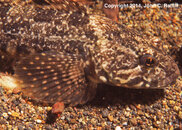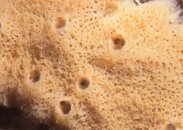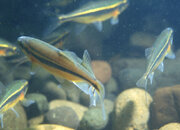I have a few suggestions about diving in fresh water. First, start by looking for little things, not big fish like you'd see in the tropics. There is actually a lot of life in the water that you are not aware of. I have a device that I fix to my mask called a SeawiscopeEY, which was developed by an optometrist, CY Tang, in Hong Kong for us older divers. He was teaching optometry at a university in Hong Kong at the time. But it also works to see in 3D very small and close objects. I have, for instance, watched a hydra on a leaf feeding off the plankton in the river for about five minutes, and the hydra was only as large an my thumb nail (measured by me). I also have observed the small sculpins feeding right before my eyes. I dive the Clackamas River near Portland, Oregon, and am ever fascinated by the underwater life, such as the crayfish (crawdad) seen below, or the freshwater sponge. I have been following the spawning habits of the redside shiner in our rivers, and they only get their red sides when spawning (see below). There are fascinating subjects in our lakes and rivers, and the
field of limnology is a great place to start study if you are interested.
Here is a short video about the SeawiscopeEY:
Below you will see some of my photos of underwater life in the Clackamas River. Photography is available even in limited visibility, but it is usually marco photography.
Now, for another rather different "take" on diving in fresh water, especially German lakes. In the early days of diving, the World Underwater Federation (CMAS), and in the United States of America the Underwater Society of America established underwater games that could be played. Now, these are highly competitive sports. One of those sports is Underwater Orienteering, and it is very popular in Germany. Here is a short video on Underwater Orienteering:
And here is another very good video in German about Underwater Orienteering:
Look it up at:
Verband Deutscher Sporttaucher e.V. Topics
SeaRat







